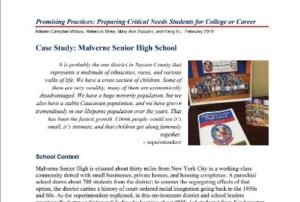Identifying Strategies and Supports to Address Chronic Absenteeism
by Amanda J. Lester; Kristen C. Wilcox (ed.)
Chronic student absenteeism, typically defined as missing 10% or more school days in one academic year for either excused or unexcused reasons, is a significant problem that effects long-term student success outcomes. Studies show that students who are chronically absent from school miss important learning opportunities. Beyond that, chronic absenteeism is shown to be a stronger predictor of student drop-out than other factors such as academic grades or standardized test scores.
While not a new challenge for educators, as more is learned about its effects, chronic absenteeism has been recognized as a “hidden educational crisis” due to the degree and severity of its impact on student learning and the ongoing challenges policymakers, educators, and family members face when seeking to address this critical issue. While a persistent and vexing challenge, gaining a greater understanding of the causes, consequences, and potential solutions for chronic absenteeism may offer insight into ways to abate its impact.
Causes of Chronic Absenteeism
The causes for chronic absenteeism can sometimes be difficult to identify because the resulting absences can be a reaction to a myriad of more complex issues that students face. The influences of poverty-based challenges, or the effects of experiencing adverse childhood experiences, are often seen as causes for chronic absenteeism. In addition, some causes for absenteeism that may be revealed through a study of a student’s overall attendance may include: health concerns, disengagement, anxiety, the fear of bullying, lack of transportation, homelessness, and/or the demands of balancing work or childcare to support the family.
Impacts of Chronic Absenteeism on Student Achievement
The prevalence of chronic absenteeism, and its impact, are shown to have a disproportionately higher effect on students of color and students living in poverty. Also, the rate of chronic absenteeism displayed by a student in the early grades has been found to be a predictor for reduced success in later grades and the increased likelihood that the student will drop out.
A range of adverse effects over time have been associated with a pattern of chronic school absences. In addition to reduced academic success and persistence, literature shows that students who have lower degrees of educational attainment, or drop-out of school, experience a greater likelihood of negative life outcomes, including chronic disease, substance abuse, and mental health challenges.
Chronic absenteeism, in the short term, reduces the effects of school-based solutions and interventions, and in the long-term results, for too many youth, in lost educational and life opportunities. Therefore, addressing the root cause for chronic absences while simultaneously providing academic supports to allay the influence of lost school time on students’ long-term academic success are high leverage strategies to tackle this crisis.
Supports and Strategies for Addressing Chronic Absenteeism
Finding successful approaches that mitigate the impact of chronic absenteeism is often noted as a particularly daunting challenge for educators. However, as identified in a 2018 Learning Policy Institute (LPI) report, a promising approach for addressing chronic absences is “to find ways to ensure that students receive the support they need to remain present and engaged in learning throughout their K-12 experiences begins with obtaining an accurate picture of how much instructional time students are losing and why”. This includes recalibrating processes for tracking student attendance, particularly since more common approaches to daily attendance-taking may mask trends that aid in better understanding causes for a student’s absence.
Once the source of a pattern of absences is identified, a high leverage approach to reducing absenteeism includes developing a system of coordinated supports that will reengage students while also addressing the cause behind their absences. This could include a variety of strategies, such as partnering disengaged students with mentors and building deeper relationships with students and families to determine which direct solutions and interventions could be most effective.
Additionally, strategies suggested in the LPI report included drawing upon opportunities being made available through the Every Student Succeeds Act (ESSA) to address chronic absenteeism by:
- Creating clear definitions of what counts as an absence;
- Including in-school and out-of-school suspensions in what counts as an absence;
- Ensuring that chronic absenteeism is addressed at all grade levels;
- Incorporating chronic absenteeism data into an early warning system; and
- Sponsoring professional development and communities of practice to share resources and connect schools with integrated supports and strategies to monitor student attendance.
Strategies supported in other literature on this topic include: reducing rates of student suspension; building a positive school climate; engaging families and communities in identifying supports students need to succeed; and establishing interdisciplinary approaches for addressing child adversity that involve pediatricians, mental health providers, educators, and public health partners.
Ways that Odds-Beating Schools in NYS are Addressing Chronic Absenteeism
The NYKids Career and College Readiness Report highlights some of the ways educators in odds-beating schools in New York State applied strategies to reduce chronic absenteeism. Many of the odds-beaters strategies mirror those identified in other research reports on chronic absenteeism.
At Sherburne-Earlville High School, and odds-beating school located in a multi-school complex in the rolling hills of New York State’s Southern Tier, school leaders and staff addressed the problem of chronic absenteeism by using the right people to connect with individual students and directly reaching out to families.
As noted by a school administrator, using the right staff members to connect with kids and families is key: “She [a teaching assistant] was perfect [for student and family outreach] because I knew her for fifteen years… I also know she cares.”
Staff and administrators at Alfred-Almond Junior-Senior High School, located in the Southern Tier of New York State, sought to address chronic absenteeism by focusing on making connections with kids, raising awareness of effects of poverty among all staff, and changing norms. “We’re looking across the board and doing a lot of professional development on poverty and how, you know, students…poverty and kids in crisis, because once again that goes hand in hand”, explained one school administrator. “And, then that goes even further to changing some of our practices…with teachers looking at things like our grading principles, our homework…we’re really seeing how it’s hit home because we can now look at it and think, you know.. that’s really not in the best interest and how do we change that.”
At Malverne Senior High School, a working-class community located about 30-miles from New York City, a focus on monitoring absentee data and reaching out to staff to offer support in meeting student needs and increasing student engagement has made a difference.
One administrator noted, “The idea is, [are] kids willfully signing up? Are they wanting the classes?… If we have people that start to move into something [other] than an effective role, we meet with them…We have someone sit down and ask, are you ok? Is there something we can do? You have high absentee rate this year, are you feeling ok? What can we do to help you?”
Helpful Resources for Educators to Address Chronic Absenteeism
The most important approach toward addressing issues with chronic absenteeism is to identify the root causes for a student’s chronic absences and then to identify strategies and resources that best meet the needs of students. In addition to findings and case study examples of schools using successful strategies, the NYKids website also offers a repository of resources that may be helpful to you and your colleagues in addressing chronic absenteeism.
To learn more, visit “Resources and Research-Addressing Chronic Absenteeism”, located at the “Improvement Resources” link on the NYKids website, or contact NYKids staff nykids@albany.edu to learn how we can provide direct support for your improvement efforts.





